When preparing a trousseau for a newborn, do not forget about such important accessories as hats and bonnets. Protection of the head is mandatory since the baby's fontanelles are open and thermoregulation is imperfect. In most maternity hospitals, cotton caps are put on immediately after the birth of babies. Mom should purchase, wash and iron several suitable size models in advance.
A newborn baby must wear a cap to protect his head from hypothermia.How to choose a hat for a baby?
A newborn will need hats for walks, and caps will protect his head at home during sleep and after bathing. Hats should be selected according to the season. In summer, thin cambric and cotton caps will come in handy. For cool evenings and the off-season, thin fleece and flannelette clothes, single-layer models made of knitted jersey or terry cloth are suitable. IN winter time You should choose two-layer models made of wool or mohair, under which you put on a thin cap.
For walks in autumn and spring, it is advisable to have two hats (with and without ties). In windy, damp weather, it is better to dress the baby in a headdress with ear protection. For warm days, a large knit model without fixation in the chin area is well suited. Winter options should cover the middle of the forehead, have ears and a warm natural lining.
There is no need to purchase models with pompoms, stripes and other decor. During a walk, the baby usually sleeps; he should be comfortable in a hat.
Newborn hat size
You can buy the first hats for a newborn at the end of the third trimester of pregnancy. When choosing a size for a mother, it is important to rely on the data from the latest ultrasound, which indicates approximate height baby and head circumference. If the baby is born on time, the diameter of its head is about 35 cm, and the length from the crown to the chin is about 14 cm. In this case, the smallest hat size for a baby is 36. If the fetus is large, it is better to purchase or sew a pair of models 38-40 size.
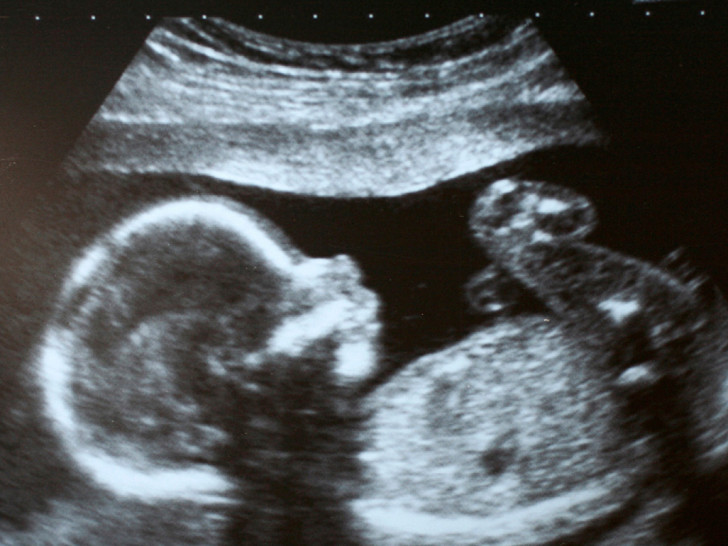 The size of the cap depends on the circumference of the child's head, which is measured by ultrasound.
The size of the cap depends on the circumference of the child's head, which is measured by ultrasound. A newborn's head grows quickly, so it is enough to prepare two thin and flannel caps and two hats of a suitable size for the season. The rest can be purchased later. If midwives recommend that the mother take a hat for the newborn to the delivery room, it is better to choose products without ties made of cotton or knitwear. One of them will probably be put on right away and get dirty. After treatment, the baby will be able to change into a clean headdress. The model with ties can be worn in the ward and on discharge.
Is a cap needed indoors?
Do newborn babies need to wear a bonnet indoors at all times? In a comfortable home environment, this is not necessary, especially since the baby is sensitive to overheating. However, in a clinic and other public spaces, it is important to protect the fragile head from accidental injuries and touches. At other times, you can let your scalp breathe.
Determining the right size: main nuances
How to determine the size of a hat for a newborn? This question often arises among parents and close relatives of the baby. It is better not to take a baby to the store, especially during a surge in infectious diseases. Perhaps the grandmother or mother of a grown-up baby will like the thing when the baby is not around. In this case, knowing its size will allow you to please your baby with a new thing.
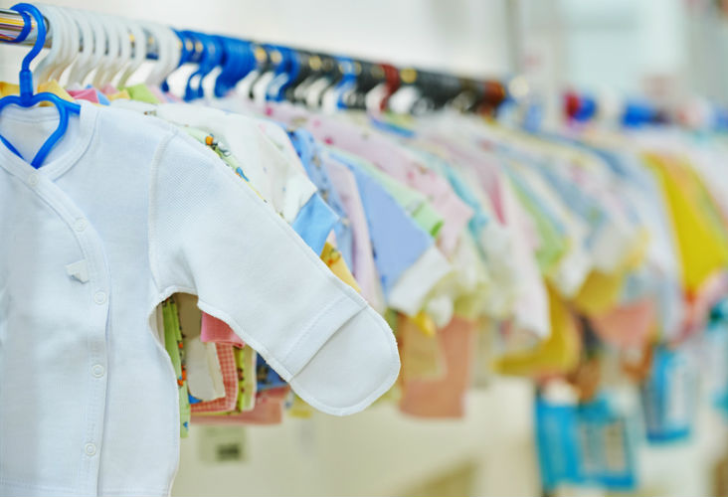 It is better to buy things for a newborn alone, having first made the necessary measurements
It is better to buy things for a newborn alone, having first made the necessary measurements Usually, when choosing a hat size, a “reference point” is used - the circumference of the child’s head at 6 months. On average, it is 43 cm. To find out the size of the head in previous periods, 1.5 cm is subtracted from this value for each month. For example, at 3 months the volume of the head is 43-1.5x3 or 40 cm. To determine the size of the hat of a baby aged from six months to a year, add 0.5 cm to 43 cm for each month lived.
In the first year, the baby's head increases by 11.5 cm. More intensive growth (8-9 cm) occurs in the first half of the year. Up to 4 months, the circumference of the head is larger than the chest, and the monthly increase in diameter is 2 cm. Then the chest grows more intensively. The head circumference of a one-year-old baby is about 48 cm; up to two years of age, 2.3-3 cm of volume is added. At the age of 2-10 years, the annual growth is 0.5 cm. The gender of the child also matters: boys have a larger head.
How to measure the circumference of a child's head?
The choice of suitable headgear depends on the correct measurement of the child’s head circumference.
You should prepare a measuring tape or woolen thread. Grasp the baby's head with it, focusing on the line of the eyebrows, the protruding part of the back of the head and the points above the ears. Carefully measure, determine the value using a tape scale or using a ruler (if thread was used).
It is important to measure head circumference to select a hat when the baby is calm.
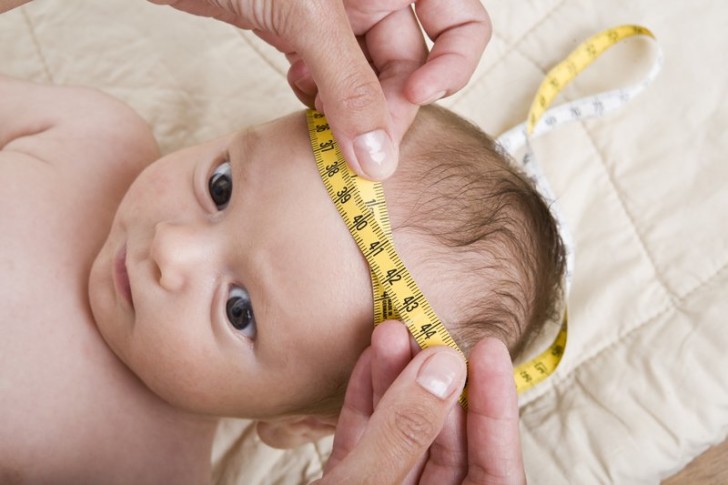 If the baby behaves calmly, you can immediately measure his head using a centimeter
If the baby behaves calmly, you can immediately measure his head using a centimeter Dimensions for knitting newborn hats with your own hands
Hats for newborns are quickly knitted using a crochet hook and knitting needles, which inspires the handicraft mother to experiment creatively. Before starting work, it is important to clarify what the diameter of the bottom is knitted product. It depends on the pattern, knitting density, type of yarn, and tightness. It is also important to immediately find out the length (height) of the model taken into work. To determine the height and diameter of the bottom, you can use the table:
| Age | Baby's head circumference, cm | Product bottom diameter, cm (head circumference divided by 3.14) | Length (depth) of the product, cm |
| 0-3 | 36 | 11,5 | 11-14 |
| 37 | 11,8 | ||
| 38 | 12,1 | ||
| 39 | 12,3 | ||
| 40 | 12,7 | ||
| 3-6 | 41 | 13,1 | 14-16 |
| 42 | 13,4 | ||
| 43 | 13,7 | ||
| 44 | 14 |
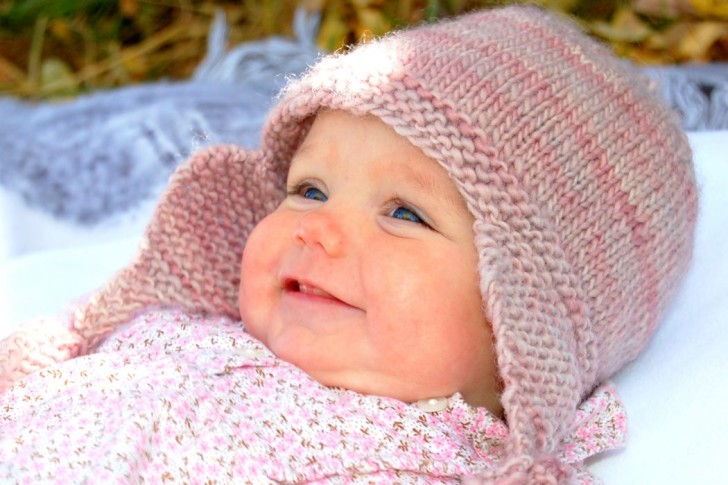
Hat size chart for babies and children under 14 years old
Hats should be purchased or sewn exactly to the baby's size. Tight models compress and impair blood circulation. Those that are too loose fall off the head, let in the cold, and during sleep they can slide down onto the face and block the access of air. The first caps serve the child for a short time, and the table presented will allow you to choose an option suitable for the head volume.
Size chart for caps and hats for children aged 0-14 years:
| Child's age | Size in cm for boy | Size in cm for girls |
| 0 months | 34-39 | 32-37 |
| 1 month | 37-41 | 35-39 |
| 3 months | 41-45 | 39-43 |
| 6 months | 43-47 | 41-45 |
| 9 months | 46-48 | 43-47 |
| 1 year | 47-49 | 46-48 |
| 1.5 years | 48-50 | 47-49 |
| 2 years | 48-52 | 48-50 |
| 3 years | 49-52 | 49-51 |
| 4 years | 50-53 | 49-52 |
| 5-6 years | 51-54 | 50-53 |
| 7-8 years | 52-55 | 51-53 |
| 9-10 years | 53-56 | 52-54 |
| 11-12 years old | 54-57 | 52-55 |
| 13-14 years old | 54-58 | 52-56 |
 The hat should fit snugly on the child’s head, but not squeeze it
The hat should fit snugly on the child’s head, but not squeeze it Manufacturers of hats for newborns and older children sew products according to the circumference of the head, designating sizes as 1 cm, 2 cm and even 4 cm. You can often find models with paired sizes (36/38, 40/42, 42/44, 46/48) . It happens that the tags indicate the head circumference and height of the baby: 36/56, 40/62, 44/68 and so on. When only age is indicated, it is quite difficult to determine the size by eye, so it is better to try on the model before purchasing.
International size chart:
How to choose a hat and bonnet for a baby?
Modern mothers are not limited in their choice of children's hats. The stores offer classic models without decor and very cute options with funny patterns and animals. Moms who love original models, sew and knit outfits on their own or to order.
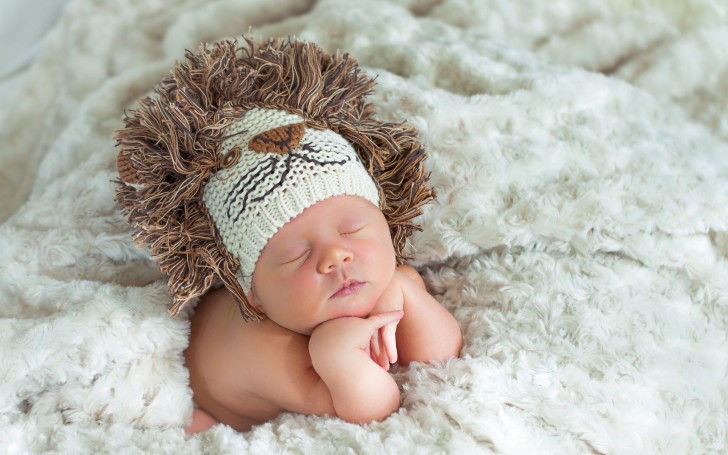 In stores you can find very original models, but the most creative ones are still knitted to order or independently
In stores you can find very original models, but the most creative ones are still knitted to order or independently You should carefully consider the material from which the children's headdress is made. Linen, cotton, cambric, wool are ideal. It is possible to purchase a hat made from combined materials: the top of the product may contain synthetics, but the lining should only be natural.
Besides the right choice size and fabric, when buying new clothes for a child, it is important to consider:
- color of the model – you should avoid bright colors due to the harmful chemical composition of the dyes;
- quality - it is advisable to purchase items from well-known brands; if after washing a colored cap stains the water, it is best not to wear it;
- absence internal seams– they can injure the child’s sensitive head;
- minimum decor - the baby should be comfortable, which many elements (buboes, bows, ribbons) will interfere with;
- convenient ties - braid or ribbons should be tied and untied quickly, without getting into knots.
Choosing comfortable and high-quality hats for your baby is only half the battle. It is important to learn how to put them on, because a newborn is very fragile, and you don’t want him to cry from careless parental actions. In the first weeks, the baby moves her arms and legs unconsciously, so the dressing process is delayed. Mom will have to learn how to change his clothes quickly and deftly.
Before a walk, the hat should be put on last, otherwise the baby's head will sweat in it, and when swaddling or fastening the overalls, the headdress may get lost, then you will have to start over. After the hat is put on your head, you should straighten the folds with your hand and hurry for a healthy walk.
The physical development of children in pediatrics is determined by four main indicators - height, weight, and head and chest circumference. The first measurement of head circumference in babies occurs in the maternity hospital at birth. And then every month, and so on until they reach one year old. Subsequently, similar measurements are made once a year until the child reaches 14 years of age. Monitoring this indicator is necessary to assess the pace of development and timely identify deviations in the child’s health.
However, the presence of deviations does not always indicate developmental problems. They may be associated with genetic predisposition.
Let's look at the main indicators that pediatricians use when taking into account head sizes and possible deviations.
Normal sizes
According to WHO, normal head circumference values are childhood from 0 to 5 years are the parameters indicated in the table below.
Physiological values of head size at age
| Physiological values of head size across ages | ||||
|---|---|---|---|---|
| Age, months | Boys | Girls | ||
| Limits of normal values | Average data | Limits of normal values | Average data | |
| 0 | 33,1–35,6 | 34,4 | 32,5–35,0 | 33,8 |
| 6 | 42,0–44,5 | 43,2 | 40,8–43,4 | 42,1 |
| 12 | 44,7–47,3 | 46,0 | 43,4–46,2 | 44,8 |
| 18 | 46,1–48,8 | 47,4 | 44,8–47,5 | 46,3 |
| 24 | 46,8–49,5 | 48,2 | 45,7–48,5 | 47,1 |
| 30 | 47,4–50,2 | 48,8 | 46,4–49,2 | 47,8 |
| 36 | 47,9–50,8 | 49,4 | 47–49,8 | 48,4 |
| 48(4 years) | 48,6–51,6 | 50,1 | 47,8–50,7 | 49,2 |
| 60(5 years) | 49,1–52,1 | 50,6 | 48,4–51,2 | 49,8 |
This age table is used by all pediatricians and neurologists.
The standards are set separately for boys and girls, since their physiological indicators are different.
How to measure head circumference?
Since every 2-3 millimeters matter, you need to measure correctly. To do this, take a centimeter and clasp your head in a circle. The main landmark should be the line of the eyebrow and the occipital protuberance.
Measurements of the child's head should be taken in a state of complete rest. If the child is naughty, you will get a false result.
Do not be afraid that the head of babies under one year old does not correspond to the proportions of the body. As you grow, everything will pass and level out. If there are any deviations, you will notice them in the baby’s behavior and appearance.
Head circumference in children under one year old
The main concerns about deviations from normal sizes occur in the first year of a baby’s life.
The head of newborns grows at a rapid pace in the first year. On average, it increases by 11.5 cm per year. Moreover, in the first half of the year it grows by 8–9 cm, and in the second by 3–4 cm, that is, it increases by 0.5 cm every month.
The most active growth of the head is observed in the first three months, when the circumference increases by 1.5–2 centimeters every 30 days. And to the beginning fourth month sizes are up to 40–41 centimeters. If previously the head circumference exceeded the chest size, then from this age they are the same. In the future, the child's head will grow more slowly, and the chest will grow more intensely. This will equalize the proportions of the body.
| Standards recommended by WHO for monitoring the head size of babies under one year old. | ||||
|---|---|---|---|---|
| Age | For boys | For girls | ||
| Acceptable range | Averages | Acceptable range | Averages | |
| 0 | 33,1–35,6 | 34,4 | 32,6–35,0 | 33,8 |
| 1 | 36,2–38,3 | 37,2 | 35,3–37,6 | 36,4 |
| 2 | 38,1–40,2 | 39,0 | 36,9–39,4 | 38,2 |
| 3 | 39,2–41,6 | 40,4 | 38,2–40,7 | 39,4 |
| 4 | 40,3–42,7 | 41,5 | 39,2–41,7 | 40,5 |
| 5 | 41,3–43,7 | 42,5 | 40,1–42,6 | 41,4 |
| 6 | 42,0–44,5 | 43,2 | 40,8–43,4 | 42,1 |
| 7 | 42,6–45,1 | 43,9 | 41,4–44,0 | 42,7 |
| 8 | 43,2–45,7 | 44,4 | 41,9–44,6 | 43,3 |
| 9 | 43,6–46,2 | 44,9 | 42,4–45,1 | 43,7 |
| 10 | 44,0–46,6 | 45,3 | 42,8–45,5 | 44,1 |
| 11 | 44,4–46,9 | 45,7 | 43,1–45,8 | 44,5 |
| 12 | 44,7–47,3 | 46,0 | 43,4–46,2 | 44,8 |
The table shows the average indicators and minor deviations from them. All these values are considered normal for a child under one year old and should not cause any concern to parents.
If the head size is above average, this may be due to physical parameters at birth - a large baby with great weight and height. This may be due to inherited physiology.
If the circumference is below average, this may be a consequence of:
- Prematurity;
- Intrauterine developmental delay;
- Heredity.
Only indicators with large deviations in one direction or another, which can be determined visually, should cause concern. Such cases in children under one year of age indicate severe developmental defects and require constant consultation and monitoring with a neurologist and pediatrician.
small head
A small head size may indicate several rare diseases:
- Microcephaly;
- Craniostenosis.
The disease is characterized by a small skull size. For a complete examination, you will need an ultrasound and an examination by an ophthalmologist.
The cause of the disease can be various intrauterine infections, congenital anomalies, birth injuries and heredity.
The disease is characterized by premature fusion of cranial sutures and indicates a malformation of the cranial bones. With such a diagnosis, consultation with a neurosurgeon will be necessary.
Big head
When a child's head grows too quickly, its large size may indicate the following diseases:
- Intracranial hypertension;
- Rickets.
Cerebrospinal fluid accumulates in the cerebral ventricles and interhemispheric sulcus. For treatment, you will need to consult a neurologist, ophthalmologist and ophthalmologist.
The head is large in size because its shape changes - the parietal part protrudes from above, and the frontal part protrudes from the front. Vitamin D is prescribed for treatment.
To evaluate your baby’s development, it is not necessary to constantly show him to the doctor. You can also do your part in monitoring your baby's development and tracking his physical growth.
For example, many parents are concerned about the head circumference of a baby in the first year of his life. Indeed, the head is actually the main part of our body. After all, it contains the brain, which controls every process in the body. And perhaps the most important aspect at the beginning of a child’s life is the formation of his head.
Why do this?
It is especially important to monitor the process of head growth for those whose children were injured during childbirth. Every woman knows what goes on during childbirth naturally, it is incredibly important to listen to the obstetrician and nurses, to be in some kind of contact with them.
Since it is from incorrect attempts that injuries to the child’s skull most often occur. And since his bones are still too fragile and vulnerable, this can leave an indelible mark on his future health and life.
In today's article we will talk about how to measure the head circumference of your child, and how to determine whether there are any pathologies or disorders in the process of its development.
So, what should you know about baby's head size by month?
Baby's head volume: everything you need to know about normal parameters
A normal head volume indicates that the baby is developing well and systematically. Deviations from the norm in in this case may indicate serious pathologies - microcephaly and hydrocephalus. However, most often such fluctuations are caused rather genetically and physiologically, that is, they are individual feature crumbs. Therefore, doctors have created a special table that indicates head growth on a monthly basis. But if previously there was only one value, now the norm column contains impressive ranges.
You need to measure your baby's head every month. This is usually done by your doctor at your traditional monthly checkup. Along with this parameter, the pediatrician checks both the height and body weight of the newborn. But if you do not have the opportunity to regularly show your child to a pediatrician, you should do all the manipulations listed above, and be sure to record the results in order to monitor the dynamics.
The first measurement of the baby's head occurs immediately after birth. At this time, the circumference should be approximately 32-35 centimeters. Over the course of a year, a child on average gains up to 12-15 centimeters in head volume, and here everything depends on the genetic characteristics of the structure of the skull, the sex of the baby and other features of its development.
Despite the fact that the volume of the head grows by 12 centimeters per year on average, it does not add a centimeter every month. Its growth peaks at three or four months of age. During this period, the head grows most actively. Until this moment, the volume will increase by about 1.5-2 centimeters, and by this age it will be about 40 centimeters.
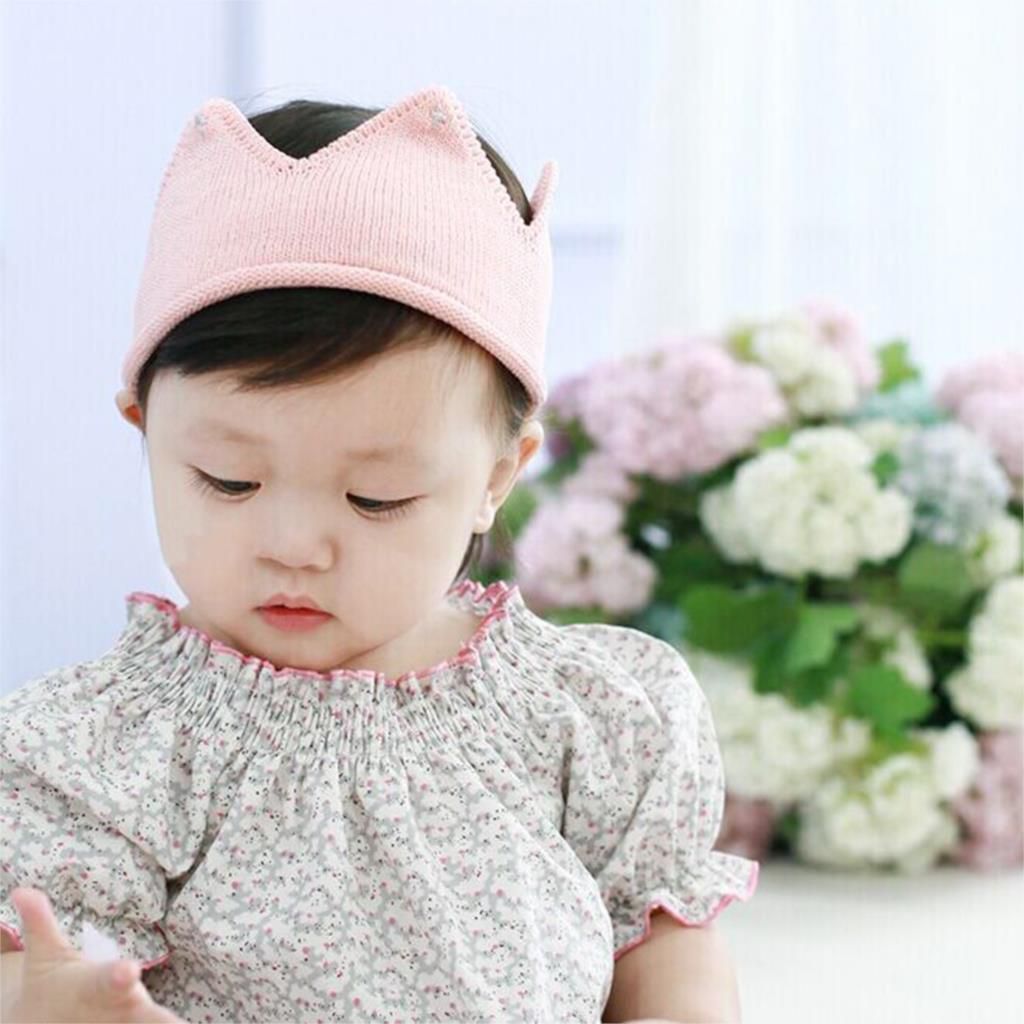
During the same period, the chest circumference will become equal to the chest circumference. Further, the growth of the first will decline and gradually slow down, while the growth of the second, on the contrary, will continue in an intensive mode.
Later, the child's chest will become much wider than his head - the way it should look in adulthood.
The normal size of a child's head at 6 months is approximately 43 centimeters.
To determine normal growth rates, it is enough to subtract one and a half centimeters per month from this value. For example, a baby's head size at five months will be 41.5 centimeters.
For example:
The head size parameter for a three-month-old baby will be 38.5 centimeters (that is, 43 - 1.5 - 1.5 - 1.5). The same applies to the size of the head of a two-month-old baby, if you subtract another centimeter and a half.
And if we talk about the size of the head of a seven-month-old child, here we should add 50 millimeters to the six-month average. For example, if at the age of six months the circumference was “ideal” 43 centimeters, then in the next month this value will not fluctuate much and will be only 43.5 centimeters.
Average parameters
If we talk about averaged indicators by month, we get something like this:
- Newborn children – 34-35 cm;
- Menstruation – 36-37 cm;
- Two months - 38-39 cm;
- Three months - 40-41 cm;
- Four months - 42-43 cm;
- Six-month olds - 43-44 cm;
- One-year-olds – 46-47 cm.
The lower threshold is more typical for girls, and the upper threshold for boys. You cannot focus solely on these indicators, since individuality should not be written off. Each person is unique in nature from birth, which means that minor fluctuations from the norm are still possible.
If the volumes of your baby’s skull do not coincide with generally accepted ones, there is no need to sound the alarm and engage in self-diagnosis using search engines on the Internet. If you are really concerned about the development of such severe pathologies as hydrocephalus and microcephaly, show your baby to the doctor. It is advisable to do this in cases where the volume grows too slowly, or, conversely, too quickly. Here it is important to focus not even on the size itself, but on how correctly or incorrectly the growth factor is progressing.
You should not forget how your baby was born. For example, if you did not carry him to term, it is quite obvious that his head will be smaller than that of a full-term baby. In addition, a premature baby will also gain volume more slowly than a healthy and strong “hero.” In post-term babies, the head may be wider immediately after birth (that is, reach a volume of more than 35 centimeters), but they gain weight in the same way as ordinary children.
If there were head injuries to the newborn during delivery, this point also cannot be written off. And this applies not only to serious injuries, but also to seemingly “harmless” hematomas and swelling.
How to determine deviations from the norm?
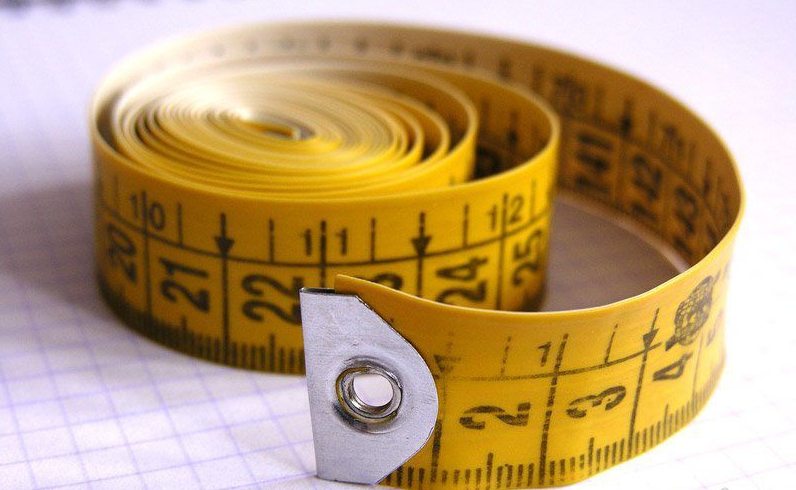
It happens that the current volumes of the head do not correspond at all to those taken as average and “ideal”. In this case, the first thing you should find out is how things went with this for you and the baby’s father. If one of the parents has a head in "tender age" was less or more than is generally accepted, it is likely that such a physiological feature is inherited by the child. Overall, there is no cause for concern here, although you should still be wary.
If nothing like this was noted in the family history (or your parents did not particularly monitor such parameters and did not save any information about them), you should still show the child to the doctor and diagnose the cause of this deviation. It is possible that there are some problems that are important to differentiate in a timely manner in order to begin adequate treatment.
It is also important to ensure that the volume of the head does not exceed the volume of the chest, except when they are compared in these indicators.
There is cause for real concern if the parameters of your baby’s head differ greatly from the generally accepted ones, and he also has any neurological disorders that an attentive mother simply cannot help but notice.
Keep an eye on your child's appearance. If, in addition to the large volume of the head, he has a divergence of the seams on it, enlargement of the fontanelles, protrusion of a pronounced venous network, a massive forehead - it is likely that hydrocephalus really exists. With this severe pathology, fluid accumulates in the baby’s brain. It is important to urgently show him to a pediatrician and neurologist in order to prescribe suitable therapy as early as possible.
Microcephaly manifests itself in the opposite way, although the same neurological disorders occur. But at the same time, the fontanelles, on the contrary, seem to be “closed”, too small, and the forehead is sloping and low. Both diagnoses are confirmed or refuted after ultrasound diagnostics. Your baby may also have to undergo a magnetic resonance imaging scan.
How to measure the head correctly?
If the volume of your baby's head does not coincide with the generally accepted volume, you should think about whether you are measuring it correctly?
You need to measure the circumference with a soft measuring tape with divisions. The front part should be on the line of the eyebrows, and the back part should be along the back of the head. It is under such conditions that the measurement will be considered correct.
In order not to torment yourself with false guesses and suspicions, we strongly recommend that you entrust such measurements to a pediatrician. Let your baby grow up healthy!
Each baby begins to grow actively when it is born, especially during the first years of its life. His height, weight and other parameters change. Monitor all indicators physical development The baby will allow parents to promptly identify deviations in his health, as well as choose the right wardrobe for him, including hats.
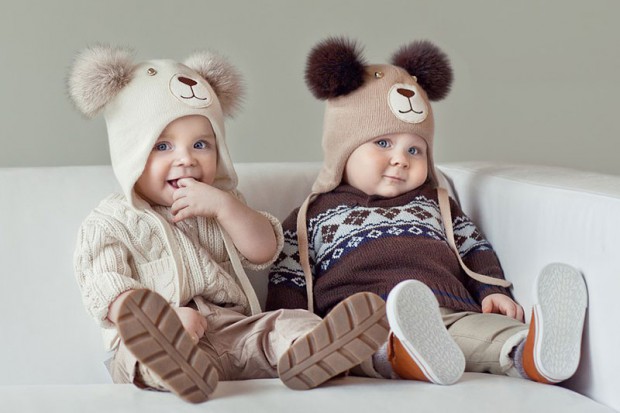
Children's hats need to be chosen correctly. So a small hat will put pressure on your baby and create discomfort for your baby, and let a larger one in, letting in the cold. Undoubtedly, best way choosing the right headgear is a fitting process. But if for some reason it is impossible, then you can choose a comfortable hat for your children if you know head circumference in children, but, and size chart will allow you not to make a mistake with your choice.
Head circumference in children, table for hats
The sizes of children's hats can be represented by different sizing grids. As a rule, it all depends on the manufacturer, many of which indicate their own size scale. Most use a grid, in which indicates the head circumference after 2 cm, some can be found after 4 cm. There are brands that use sizes to mean height and age. Therefore, the size of hats based on head circumference and age are the main parameters that need to be taken into account when choosing a headdress for children.
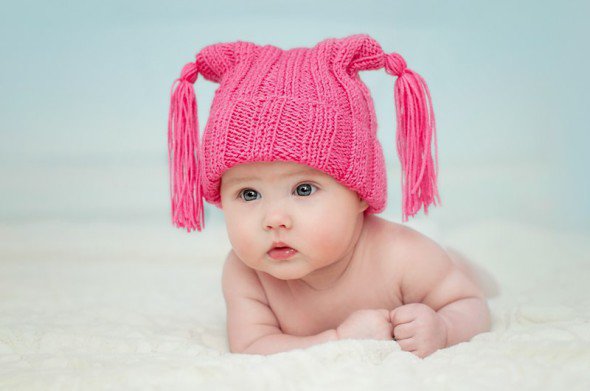
Now we will look at the size of hats by age and start with such an important point as head circumference in children under one year old, since the choice of hats for a newborn is the most pressing issue among young mothers. So, a headdress for little ones should be comfortable and not cause harm. If we take the average height of a newborn (50-54 cm), then the size of a baby’s hat is 35 (head circumference for children under one year old).
Children aged 2 to 5 years mainly wear hats measuring from 48-52 cm with a height of 0.9-1.1 cm. For the age group of children from 6 to 10 years old, hats from 53 to 56 cm with a height are suitable from 1.1 to 1.5 m. Let us note once again that the indicated dimensions correspond to the length of the head circumference. Therefore, in order not to make a mistake when choosing a children's headdress, you need to know the head circumference of children, but the size table will allow you to make a quick and correct purchase.
Table of hat sizes for children under one year old

Children's head circumference size chart
The birth of a child is a moment of great happiness for new parents. The young mother and father cannot stop looking at their child and constantly carry him in their arms. With the birth of a baby, the life of the spouses changes significantly - now they are responsible not only for themselves, but also for little man, which was born. Some parents are aware of the full responsibility long before giving birth, while for others this feeling appears only after birth. But absolutely all mothers and fathers, first of all, wish their baby health.
The first year of a child's life is considered by many to be one of the most difficult years for parents. Especially if the baby is the first-born. Many fears visit inexperienced mothers and fathers during this period. Parents are afraid that the baby will get sick and that nothing will happen to him.
Thanks to modern free access to almost any information, parents have the opportunity to monitor the development of their child without the constant need to consult a doctor. One of important signs healthy development is the head circumference of a child up to one year old. Today, mothers and fathers can easily measure this indicator at home, and only in case of any deviations can they make an emergency appointment with a pediatrician.
At the time of birth, the size of the child’s head circumference is 34-35 cm. Up to a year, the size of the child’s head increases rapidly and becomes 10 cm larger. This indicates that the baby is developing normally, without deviations. Starting from the moment of birth, the newborn's head changes every month. There are special standards that guide doctors and parents. The change in the volume of a child's head slows down significantly after a year. After 12 months, monthly measurements of this indicator of the baby’s development are not carried out.
Table of changes in head circumference of a child up to one year
| Age | Head circumference, cm | |
|---|---|---|
| Boys | Girls | |
| 1 month | 37,3 | 36,6 |
| 2 months | 38,6 | 38,4 |
| 3 months | 40,9 | 40,0 |
| 4 months | 41,0 | 40,5 |
| 5 months | 41,2 | 41,0 |
| 6 months | 44,2 | 42,2 |
| 7 months | 44,8 | 43,2 |
| 8 months | 45,4 | 43,3 |
| 9 months | 46,3 | 44,0 |
| 10 months | 46,6 | 45,6 |
| 11 months | 46,9 | 46,0 |
| 12 months | 47,2 | 46,0 |
For every month up to six months normal development the circumference of the child's head should increase by 1.5 cm. After 6 months, the change in the size of the baby's head becomes less intense and amounts to 0.5 cm per month.
Measuring the head circumference of a child under one year of age is carried out at an appointment with a pediatrician. However, very curious parents can measure this indicator of their baby’s development at home. To do this, you need a special soft tape with centimeter markings. The measurement should be taken through the line of the eyebrows and the back of the baby’s head.
Any deviations in changes in the volume of a child’s head are a serious cause for concern. If parents regularly show their baby to the pediatrician, then the doctor will be able to determine deviations from the norm at the most early stages. Otherwise, if parents prefer to measure all indicators of their child’s physical development on their own and skip visits to the doctor, then if there are any deviations, you should immediately attend an appointment. Since ![]() The change in the size of a child’s head up to one year is an indicator of the development of his brain and central nervous system.
The change in the size of a child’s head up to one year is an indicator of the development of his brain and central nervous system.
After a year, the change in the size of a child's head slows down significantly. In the second year of life, babies, as a rule, gain only 1.5-2 cm, in the third year - 1-1.5 cm.
Every mother and father should remember that the key to complete physical, spiritual and mental development their child takes regular walks in the fresh air, breast-feeding, good sleep and motor activity. In addition, a friendly atmosphere in the family and loving parents play a huge role in the baby’s well-being.



